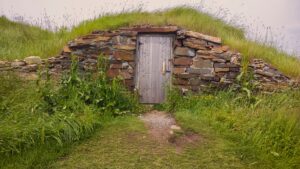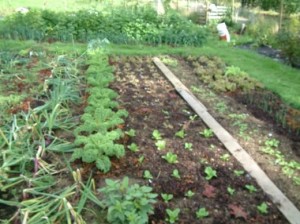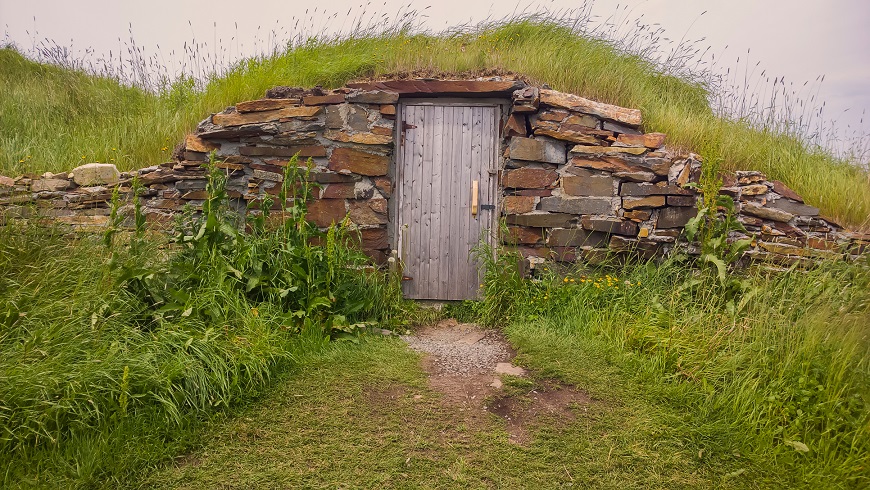Build a Root Cellar to Store Food
 Do you want to store your food safely and naturally? If yes, then building a root cellar is a great way to do it. A root cellar is an underground room or a large container that is used to store food and other items at a constant temperature and humidity. It’s a great way to keep food safe from the elements and to keep it from spoiling quickly. Plus, it’s a great way to save money by buying in bulk and storing it for a longer period of time. Read on to learn how to build your own root cellar and how to keep it running smoothly!
Do you want to store your food safely and naturally? If yes, then building a root cellar is a great way to do it. A root cellar is an underground room or a large container that is used to store food and other items at a constant temperature and humidity. It’s a great way to keep food safe from the elements and to keep it from spoiling quickly. Plus, it’s a great way to save money by buying in bulk and storing it for a longer period of time. Read on to learn how to build your own root cellar and how to keep it running smoothly!
I. Introduction
The introduction of root cellaring as a form of food storage is an ancient and important practice. Root cellaring is a method of storing food that is both efficient and cost effective. It requires no electricity or additional refrigeration, instead relying on traditional food preservation techniques and the natural environment to store food. Root cellaring can be used to store a variety of food items such as vegetables, fruits, nuts, and grains. It is a great way to store food for long periods of time, and to ensure that food quality and freshness is maintained. In this article, we will discuss the basics of root cellaring, including the best practices for setting up and maintaining a root cellar and the different types of food items that can be stored in a root cellar.
A. Definition of a Root Cellar
A root cellar is a structure, typically underground, that is used to store fruits, vegetables, and other perishable items. Root cellars are designed to maintain a temperature and humidity level that is ideal for the preservation of fruits and vegetables. The temperature should typically be between 32 and 40 degrees Fahrenheit, while the humidity should be between 85 and 95 percent. A good root cellar should also be free of rodents and insects. The ideal location for a root cellar is below ground, usually in the basement or a crawlspace, as this will help naturally maintain the desired temperature and humidity levels. Additionally, root cellars should be well ventilated to help keep the air circulating and to prevent mold from forming. Proper insulation should also be used to help maintain the desired temperature and humidity levels. Finally, root cellars should be kept clean and neat to help prevent the spread of disease and pests.
B. Benefits of Having a Root Cellar
 Having a root cellar offers a variety of benefits. It allows you to store food, such as fruits and vegetables, for long periods of time without the need for refrigeration. This means that you can purchase fresh produce in bulk when it is in season and store it for months at a time. This not only helps to save money, but it also ensures that you always have a supply of fresh produce on hand. Additionally, a root cellar is an excellent way to store and preserve homemade jams, jellies, and other preserves, as well as dried meats and nuts. By having a root cellar, you can enjoy the taste of freshly picked fruits and vegetables all year round. Furthermore, it is an eco-friendly way to store food, as it does not require the use of electricity, and it can help reduce food waste.
Having a root cellar offers a variety of benefits. It allows you to store food, such as fruits and vegetables, for long periods of time without the need for refrigeration. This means that you can purchase fresh produce in bulk when it is in season and store it for months at a time. This not only helps to save money, but it also ensures that you always have a supply of fresh produce on hand. Additionally, a root cellar is an excellent way to store and preserve homemade jams, jellies, and other preserves, as well as dried meats and nuts. By having a root cellar, you can enjoy the taste of freshly picked fruits and vegetables all year round. Furthermore, it is an eco-friendly way to store food, as it does not require the use of electricity, and it can help reduce food waste.
II. Building a Root Cellar
A root cellar is an underground storage room specifically designed to store root vegetables, fruits and nuts at a consistent, cool temperature and high humidity. Building a root cellar can be a great way to extend the storage life of your food while reducing the amount of food waste. Root cellars are often built with stone or concrete walls, a sloped roof and a thick layer of insulating material like straw or sawdust to keep the temperature and humidity levels consistent. A vent and fan system can also be used to control these levels, as well as to bring in fresh air. In addition, a root cellar should be waterproof and sealed to keep out rodents and other pests. Building a root cellar is a great way to ensure that your food is stored in the best possible conditions, and will remain fresh for longer.
A. Choosing a Location
Choosing a location for a root cellar is an important decision that should not be taken lightly. The ideal location for a root cellar should be away from direct sunlight and should have a good supply of moisture. The soil should be well-draining and have a neutral to slightly acidic pH level. Additionally, it should also be located in an area that is not prone to flooding or extreme temperatures. Furthermore, the location should be close to a water source and have good air circulation to reduce humidity. It is also important to note that the location should be away from any sources of pests to ensure that food stored in the root cellar remains safe. In general, the best location for a root cellar is underground, as this will help to maintain an even temperature and provide the necessary insulation to keep food safe.
B. Constructing the Cellar
Constructing the Cellar is an important step in building a root cellar to store food. This part of the process involves digging a hole or trench that is large enough to hold the desired amount of food and is deep enough to keep the food at a consistent temperature. The size and depth of the cellar will depend on the size of the food items you are storing, as well as the specific climate you live in. Additionally, it is important to consider the soil type and drainage when selecting the location for your root cellar and to consider the use of a water-resistant material such as concrete or stone to line the cellar walls. Finally, the cellar should be well-ventilated to ensure that the food does not spoil and is properly cooled.
C. Insulating the Cellar
C. Insulating the Cellar is an important step in building a root cellar to store food. A properly insulated root cellar can help keep temperatures consistent and minimize the risk of spoilage or spoilage-causing organisms such as bacteria, mold, and mildew. The insulation should be installed on the walls and ceiling of the cellar, and all seams should be sealed with a caulking material to prevent cold air from entering the space. Additionally, the entrance should be well-sealed to prevent cold air from entering, and the walls should be insulated with an appropriate material such as fiberglass or foam. Insulating the cellar properly can also help keep the temperature uniform throughout the space.
III. Storing Food in a Root Cellar
A root cellar is a great way to store food, as it allows you to keep your food cool and dry, and can help maintain a consistent temperature. The ideal temperature for a root cellar is between 32-40 degrees Fahrenheit, and the ideal humidity is between 65-80%. Many root cellars are built underground to help insulate them from the heat of the sun and keep the temperature more stable year-round. When storing food in a root cellar, it is important to keep the food away from light, as light can cause food to spoil. It is also important to keep the food dry, as moisture can cause food to rot or mold. To protect the food from pests, it is a good idea to wrap it tightly in plastic, or to use a sealed container. It is also important to rotate the food in a root cellar, as older food items should be used first to ensure the freshness of the food.
A. Storing Fruits and Vegetables
A root cellar is an excellent way to store fruits and vegetables for long-term use. It provides a cool, dark, and moist environment, which is perfect for storing produce. The temperature should be slightly below freezing, and the humidity should be maintained at around 50-60%. This will keep the produce fresh and prevent it from spoiling. It is important to ensure that the air in the root cellar is well-circulated to prevent the build-up of moisture, which can lead to mold growth. Additionally, it is important to check the produce regularly for signs of spoilage and to rotate older items to the front of the cellar to ensure that they are used in a timely manner. With proper care, a root cellar can be a great way to extend the shelf-life of fruits and vegetables.
B. Storing Dairy and Meat Products
Storing dairy and meat products requires special attention to ensure the food remains safe to eat. To store dairy and meat products effectively, you need to build a root cellar that is designed to keep temperatures at an even, cool level. This will help to prevent spoilage and food-borne illness. You also need to ensure that the root cellar is properly ventilated and has adequate humidity control. Additionally, it is important to store dairy and meat products in airtight containers to prevent them from spoiling and to protect them from contaminants. Additionally, it is important to store meat and dairy products in separate containers and to regularly monitor the temperature of the root cellar to ensure it remains at the ideal temperature. With proper storage, dairy and meat products can last up to several months.
IV. Conclusion
The conclusion is an important part of any project. In this case, it is important to carefully consider the pros and cons of building a root cellar to store food. Building a root cellar can be a great way to store food for extended periods of time, as it provides a cool, dark environment that is ideal for food storage. The construction of a root cellar can be a labor-intensive and costly undertaking, however, and it is important to consider the potential risks, such as flooding or pests, before committing to the project. Additionally, it is important to consider the cost-effectiveness of the project, and whether or not the benefits of a root cellar outweigh the costs. Ultimately, the decision to build a root cellar should be made after careful consideration of all the factors involved.
A. Summary of Benefits of a Root Cellar
A root cellar is an excellent way to store food for long-term use. Not only is it an inexpensive and simple way to preserve food, it can also provide many benefits. A root cellar helps to keep food at a consistent temperature and humidity, which helps to reduce the risk of spoilage. This can help to extend the shelf life of many food items, allowing them to be stored for longer periods of time. Additionally, it can help to reduce the amount of energy consumed when cooling food, as the root cellar can provide a natural cooling environment. Finally, a root cellar can also provide a secure and convenient way to store food, as it is difficult for pests to get inside and the food is stored in a cool and dark space. All in all, root cellars provide a great way to store food for long-term use and are an excellent way to save money and energy.
B. Final Thoughts on Building and Using a Root Cellar
Building and using a root cellar is an excellent way to extend the shelf-life of vegetables, fruits, and other perishables. It can also help preserve the harvest from your garden, ensuring you have food to last through the winter months. A root cellar is a great investment for any homesteader, especially those in regions with cold climates. Not only will it provide a secure place to store food, but it can also help to maintain ideal temperature and humidity levels, which will help to prolong the life of your stored foods. Additionally, a root cellar can be an excellent source of passive cooling, allowing you to save money on energy costs. With a little bit of research, planning, and effort, you can easily build a root cellar that will serve your family for many years to come.



